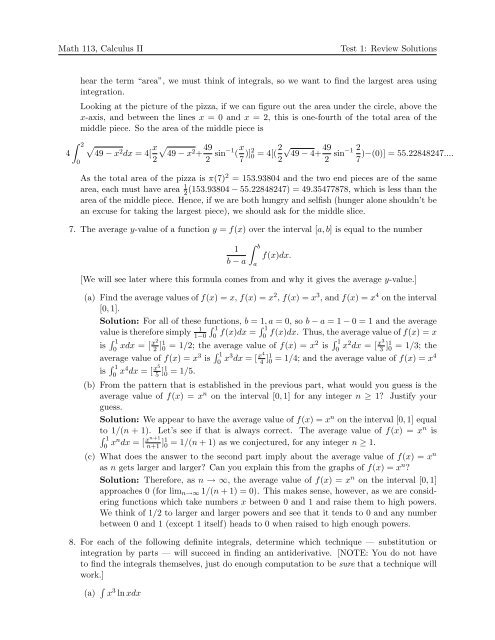Solutions to Practice Problems
Solutions to Practice Problems
Solutions to Practice Problems
Create successful ePaper yourself
Turn your PDF publications into a flip-book with our unique Google optimized e-Paper software.
Math 113, Calculus II<br />
Test 1: Review <strong>Solutions</strong><br />
4<br />
∫ 2<br />
0<br />
hear the term “area”, we must think of integrals, so we want <strong>to</strong> find the largest area using<br />
integration.<br />
Looking at the picture of the pizza, if we can figure out the area under the circle, above the<br />
x-axis, and between the lines x = 0 and x = 2, this is one-fourth of the <strong>to</strong>tal area of the<br />
middle piece. So the area of the middle piece is<br />
√<br />
49 − x 2 dx = 4[ x √<br />
49 − x<br />
2 2 + 49<br />
2 sin−1 ( x 7 )]2 0 = 4[( 2 √ 49 2 49 − 4+<br />
2 2 sin−1 )−(0)] = 55.22848247....<br />
7<br />
As the <strong>to</strong>tal area of the pizza is π(7) 2 = 153.93804 and the two end pieces are of the same<br />
area, each must have area 1 2<br />
(153.93804 − 55.22848247) = 49.35477878, which is less than the<br />
area of the middle piece. Hence, if we are both hungry and selfish (hunger alone shouldn’t be<br />
an excuse for taking the largest piece), we should ask for the middle slice.<br />
7. The average y-value of a function y = f(x) over the interval [a, b] is equal <strong>to</strong> the number<br />
1<br />
b − a<br />
∫ b<br />
a<br />
f(x)dx.<br />
[We will see later where this formula comes from and why it gives the average y-value.]<br />
(a) Find the average values of f(x) = x, f(x) = x 2 , f(x) = x 3 , and f(x) = x 4 on the interval<br />
[0, 1].<br />
Solution: For all of these functions, b = 1, a = 0, so b − a = 1 − 0 = 1 and the average<br />
value is therefore simply 1 ∫ 1<br />
1−0 0 f(x)dx = ∫ 1<br />
0<br />
f(x)dx. Thus, the average value of f(x) = x<br />
is ∫ 1<br />
x2<br />
0<br />
xdx = [<br />
2 ]1 0 = 1/2; the average value of f(x) = x2 is ∫ 1<br />
0 x2 dx = [ x3<br />
3 ]1 0 = 1/3; the<br />
average value of f(x) = x 3 is ∫ 1<br />
0 x3 dx = [ x4<br />
4 ]1 0 = 1/4; and the average value of f(x) = x4<br />
is ∫ 1<br />
0 x4 dx = [ x5<br />
5 ]1 0 = 1/5.<br />
(b) From the pattern that is established in the previous part, what would you guess is the<br />
average value of f(x) = x n on the interval [0, 1] for any integer n ≥ 1? Justify your<br />
guess.<br />
Solution: We appear <strong>to</strong> have the average value of f(x) = x n on the interval [0, 1] equal<br />
<strong>to</strong> 1/(n + 1). Let’s see if that is always correct. The average value of f(x) = x n is<br />
∫ 1<br />
0 xn dx = [ xn+1<br />
n+1 ]1 0 = 1/(n + 1) as we conjectured, for any integer n ≥ 1.<br />
(c) What does the answer <strong>to</strong> the second part imply about the average value of f(x) = x n<br />
as n gets larger and larger? Can you explain this from the graphs of f(x) = x n ?<br />
Solution: Therefore, as n → ∞, the average value of f(x) = x n on the interval [0, 1]<br />
approaches 0 (for lim n→∞ 1/(n + 1) = 0). This makes sense, however, as we are considering<br />
functions which take numbers x between 0 and 1 and raise them <strong>to</strong> high powers.<br />
We think of 1/2 <strong>to</strong> larger and larger powers and see that it tends <strong>to</strong> 0 and any number<br />
between 0 and 1 (except 1 itself) heads <strong>to</strong> 0 when raised <strong>to</strong> high enough powers.<br />
8. For each of the following definite integrals, determine which technique — substitution or<br />
integration by parts — will succeed in finding an antiderivative. [NOTE: You do not have<br />
<strong>to</strong> find the integrals themselves, just do enough computation <strong>to</strong> be sure that a technique will<br />
work.]<br />
(a) ∫ x 3 ln xdx
















